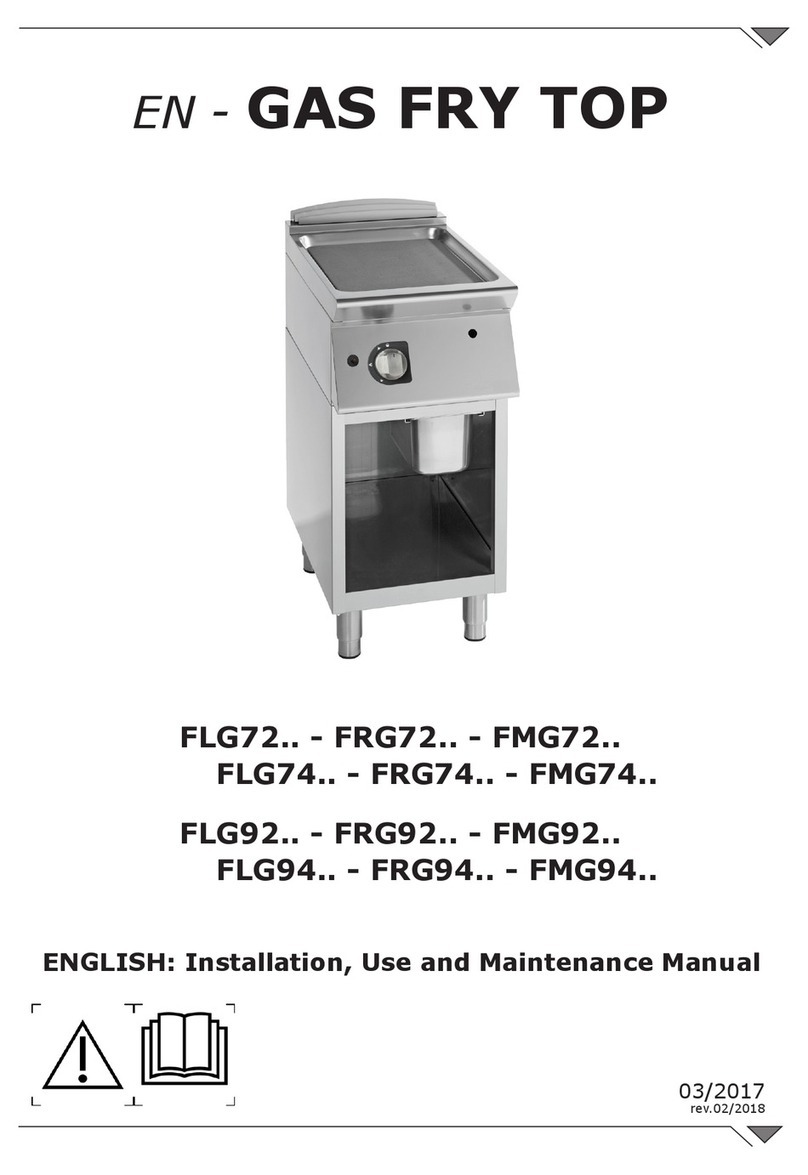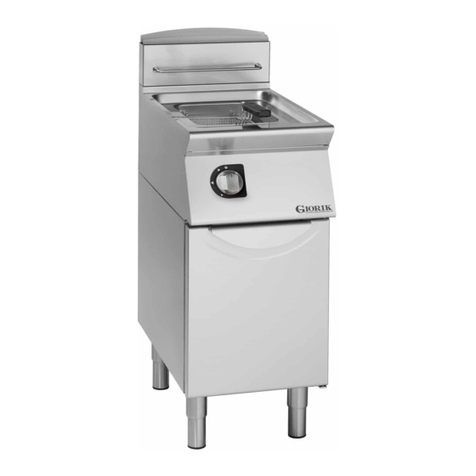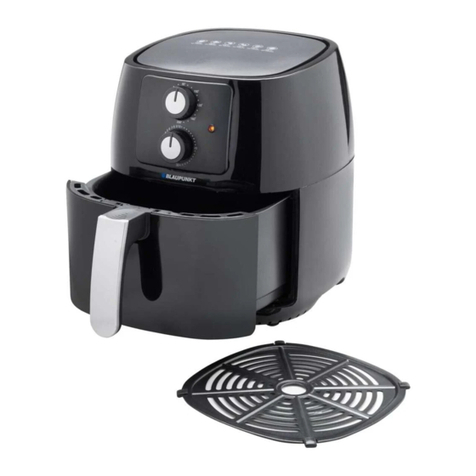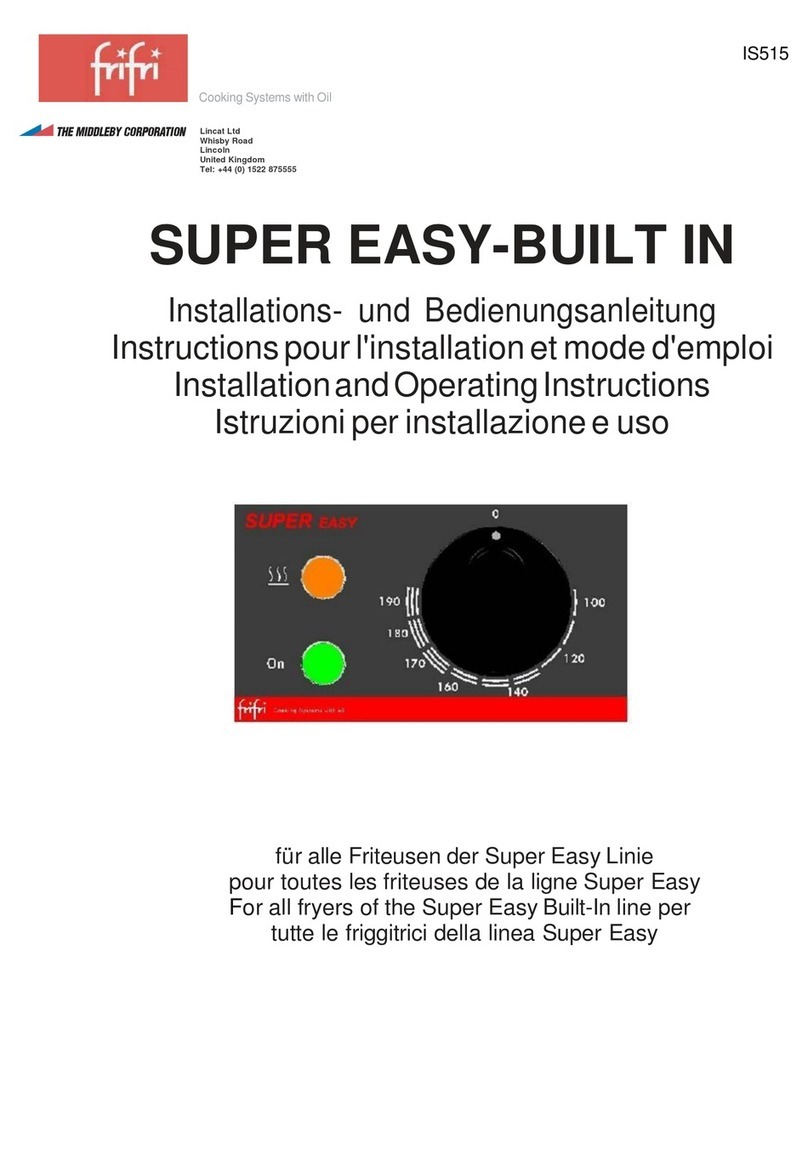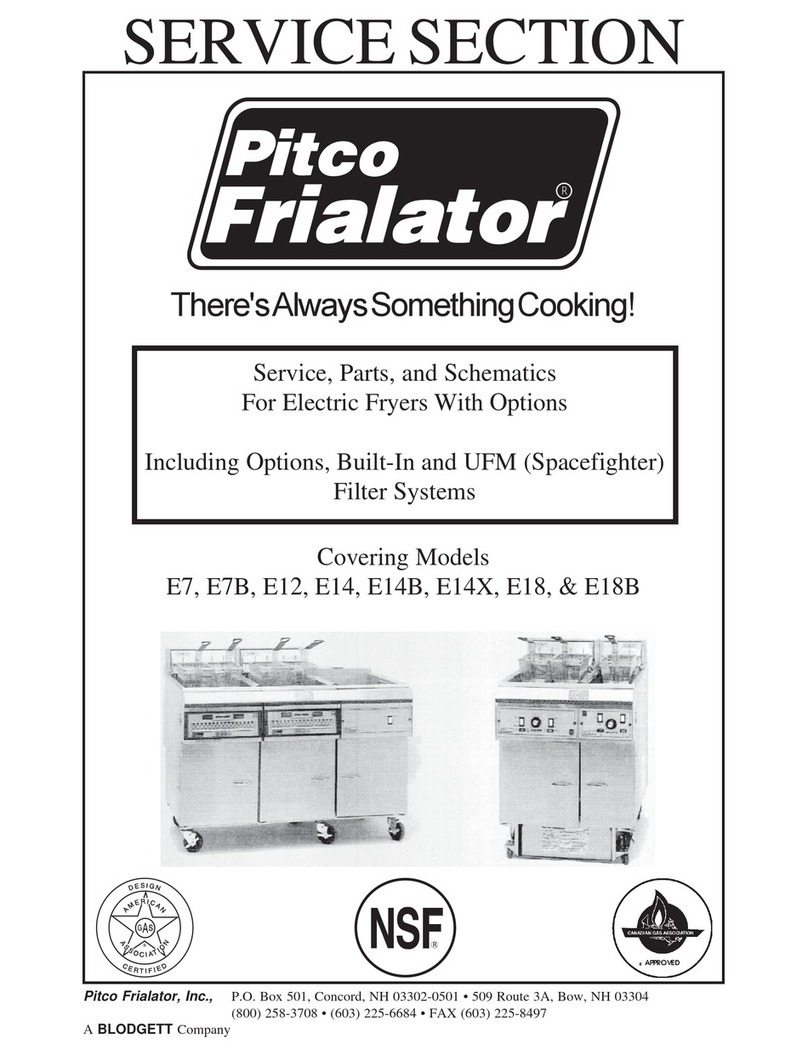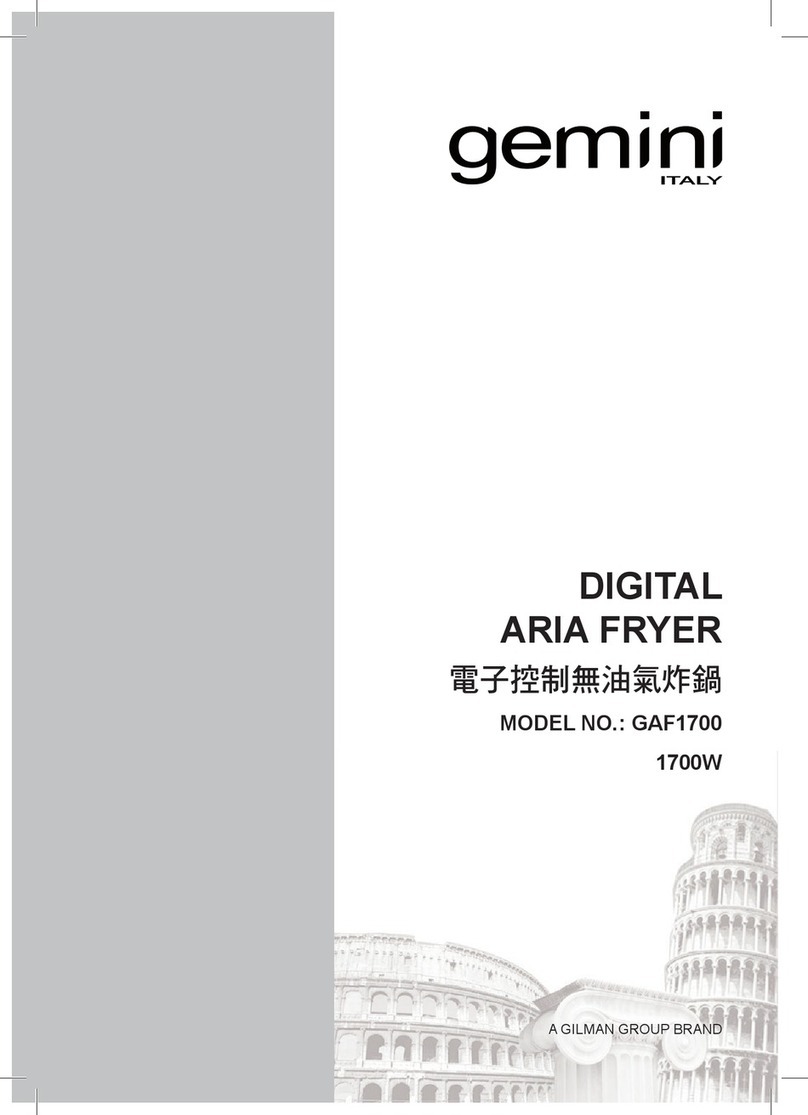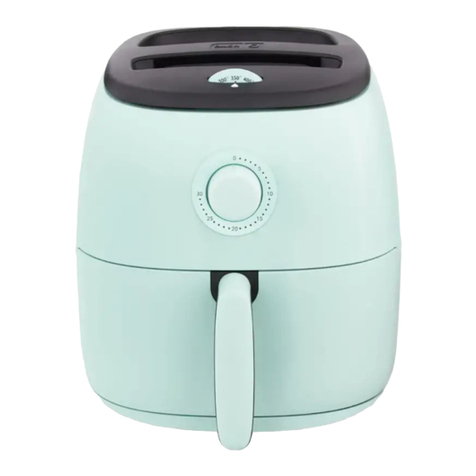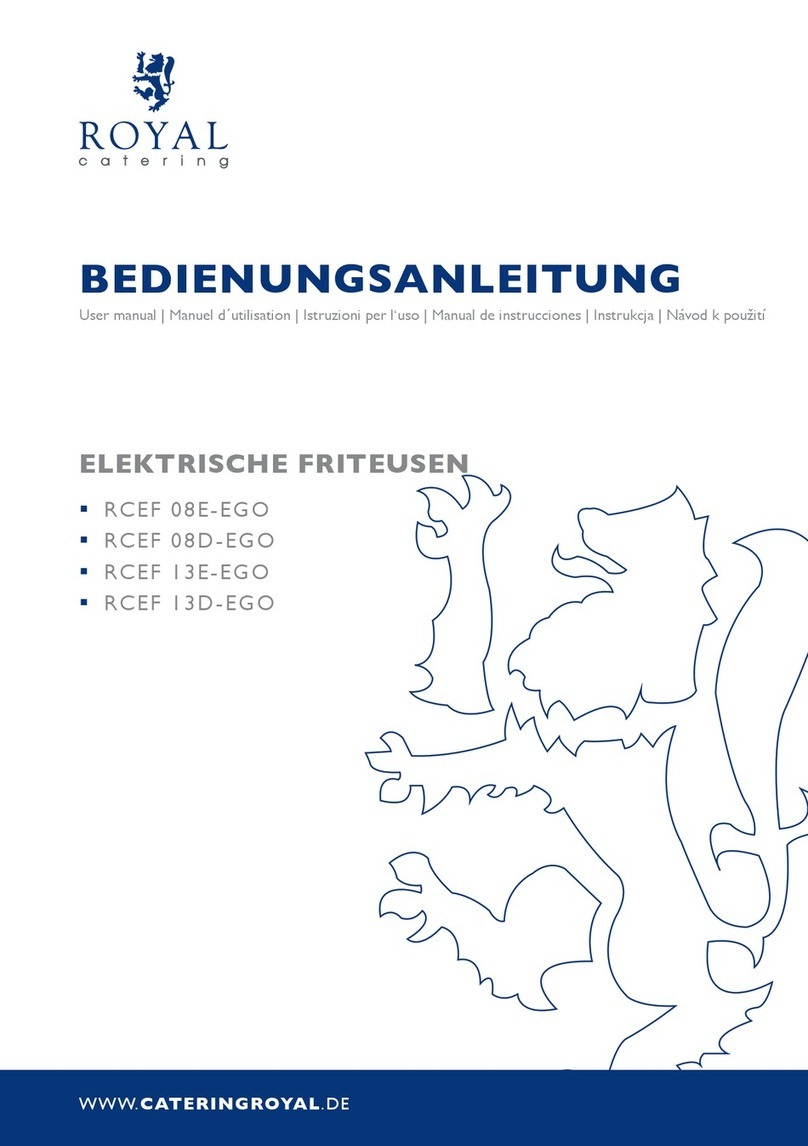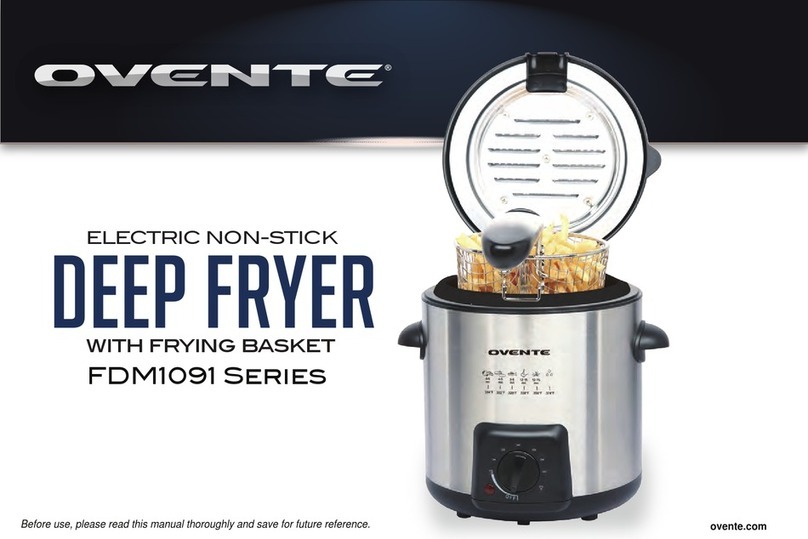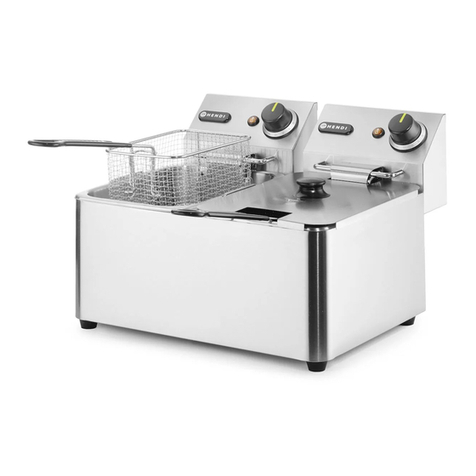Giorik 700 Series User manual

210FE / 210FE-C / 15FE / 15FEC / 20FE / 20FEC
/ F215L / F215CL / 215FE / 215FEC / 220FE /
220FEC / 922FE / 922FE-C / 915FE / 915FEC
/ 920FE / 920FEC / 921FE / 921FEC / 940FE /
940FEC / 942FE / 942FEC
Rev. 02-2015
•GB - INSTALLATION AND OPERATION MANUAL
•DE- INSTALLATIONS- UND BEDIENUNGSHANDBUCH
Electric deep fat Fryers
Elektrische Fritteusen

2
ENG
TABLE OF CONTENTS
1InstallatIon 3
1.1 General and safety warnings 3
1.2 Positioning 6
1.3 Electrical connection 6
1.4 Equipotential 8
2technIcal features 9
3operatIng InstructIons 10
3.1 Warnings and Operation 10
3.2 Switching on 10
3.2.1 Deep Fryer switch on with MELTING (where provided) 11
3.2.2 Voltage Outage 13
3.2.3 Warnings and Alarms 13
3.3 Safety thermostat 14
3.4 Switching off 14
3.5 Emptying the tank 15
4MaIntenance 15
4.1 Cleaning and care of the appliance 15
4.2 In the event of malfunction 16
4.3 Appliance disposal 16
5WIrIng DIagraMs (from page 35 to page 50 for all models)35
Dear customer,
We would like to thank you for your preference in purchasing one of our
products.
This appliance belongs to a comprehensive range of equipment specically
designed for catering. These appliances enclose great user friendliness and
ergonomics in a pleasant and modern design.
The appliance has a 12 month warranty against any manufacturing defects
as from the date indicated on the sale invoice. The warranty covers normal
operation and does not include consumables (light bulbs etc.) and faults
caused by incorrect installation, maintenance, repairs and cleaning, tampering
and misuse.
The manufacturer reserves the right to make the changes it deems necessary
or useful at any time.

3
ENG
1. INSTALLATION
1.1 General and safety warnings
Carefully read this manu-
al before installation and
commissioning of the ap-
pliance, as the text pro-
vides important indica-
tions concerning appliance
safety in installation, op-
eration and maintenance.
Store this manual with care
and in an easily accessi-
ble place for any further
referencing by operators.
Always attach the manual
in the event of transfer of
the appliance; should it be
required, a new copy must
be obtained from the au-
thorised dealer or directly
from the manufacturer.
As soon as packaging is re-
moved, ensure the appli-
ance is intact and does not
show any damage caused
by transport. In no case
shall a damaged appliance
be installed and commis-
sioned; if in doubt imme-
diately contact the techni-
cal support or your dealer.
Before connecting the ap-
pliance ensure the pow-
er cable supplied is not
damaged, in which case
the cable must be re-
placed by the service or
by qualied personnel.
Before connecting
the appliance ensure
the rated data match
those of the electric-
ity distribution network.
For direct connection to
the power supply network
it is required to interpose
a device between the ap-
pliance and the network,
to assure disconnection
and whose contacts have
an opening distance such
as to assure complete
disconnection in over-
voltage category III con-
ditions, in compliance
with installation rules
Appliance installation, ex-
traordinary maintenance
and repair operations must
be solely effected by pro-
fessionally skilled person-

4
ENG
nel and following the man-
ufacturer's instructions.
The appliance has been
designed to cook food
in closed environments
and must be solely em-
ployed for this purpose:
any other use must
therefore be avoided
as hazardous misuse.
The appliance must only
be used by personnel
suitably trained in its use.
To avert the risk of acci-
dents or damage to the
appliance it is also es-
sential for the personnel
to regularly receive pre-
cise instructions on safety.
The appliance must not be
used by persons with lim-
ited physical, sensory or
mental abilities or by per-
sons without experience
and knowledge, unless
they are supervised or in-
structed with regards to
appliance use by a person
responsible for their safety.
Children should be super-
vised to ensure they do
not play with the appli-
ance nor use it.
Before commissioning the
appliance ensure all pack-
aging parts have been re-
moved, then make sure to
dispose of them in compli-
ance with current regula-
tions.
In the event the appli-
ance should be positioned
against a wall, the wall
must withstand tempera-
ture of 80°C and if am-
mable, application of
thermal insulation is com-
pulsory.
Do not obstruct the ex-
traction or heat disposal
openings or slits.
During operation it is re-
quired to pay attention to
the hot areas of the outer
surface of the appliance
which, during operation,
may even exceed 60° C.
Do not deposit nor use
ammable substances
near the appliance.
In the event of fault or
malfunctioning, the ap-
pliance must be disabled;
for any repairs solely con-
tact a technical support

5
ENG
centre authorised by the
manufacturer and de-
mand original spare parts.
Any modication to ap-
pliance installation that
should be required shall be
approved and performed
by authorised technical
personnel.
The appliance is only in-
tended for professional
use and by qualied per-
sonnel.
Power off the appliance
before performing any
maintenance or repair.
No modications to the
appliance's wiring of any
kind are admissible.
In the event of prolonged
appliance disuse, the sup-
ply of electricity must be
discontinued.
Failure to comply with
the above warnings may
jeopardise the appliance's
safety as well as your own.

6
ENG
100
50
Fig. 1
Fig. 3
1.2 Placement
The appliance has been designed to be installed in closed premises;
it cannot be used outdoors and must not be exposed to weathering.
The designated installation location must
have a rigid, at and level surface that must
be able to safely withstand the weight of the
appliance loaded to maximum capacity.
The appliance must be transported to the in-
stallation location in its packaging and it must
be handled implementing all due precautions
to prevent tipping over.
The appliance must be installed at a mini-
mum distance of 100 mm from the side wall
and 50 mm from the rear wall (g.1).
The appliance must be placed level; to adjust height of the levelling
feet use a bubble level as reference, as shown in g.2.
Ensure the extraction and/or heat
disposal opening and slits are not ob-
structed in any way.
Remove the protective lm from the
outer panels, detaching it slowly to
prevent glue residues from remaining
attached to the walls.
The appliance must be installed in
an area where accidental contact with
water is not possible.
It is recommended to place the appliance underneath an extraction
hood.
1.3 Electrical Connection
By removing the components showing the symbol ing.3,
access is gained to the appliance's live parts; this operation
must be performed by qualied personnel.

7
ENG
Fig. 4
MOD
FEXXXX
NR
XXXXXX/XX/XX
POWER SUPPLY
400V 3N 50/60 Hz
TOT POWER kW
14,0 IP
The electrical system - as required and specied in regulation in
force - must be equipped with efcient earthing.
Electrical safety of the appliance may only be assured if the electrical
installation is compliant.
Before performing electri-
cal installation, voltage and
frequency readings of the
power grid should be moni-
tored to ensure they meet
the requirements of the ap-
pliance indicated in its rat-
ing plate (g. 4), attached
to the inside of the cabinet
door.
For direct connection to the power supply network a device, sized
according to the load, must be placed between the appliance and the
network, to assure disconnection and whose contacts have minimum
opening distance assuring complete disconnection in overvoltage
category III conditions, in compliance with the installation rules;
this device must also be positioned in a place and in such a way as to
be readily operable at any time by the operator.
Move the main switch the power supply plug is to be connected to
into position 0 (zero). Have professionally qualied personnel ensure
the section of the plug cables is adequate to the appliance's power
intake.
The power supply cable must be at least type H05 RN F and have
adequate section for the appliance (see tab. I).
The connection terminal board is inside the power supply box, located
inside the cabinet on the right. Run the cable through the fairlead and
cable gland, connect the wires to the corresponding terminal of the
terminal board and secure them.
The earth wire must be longer than the other ones so that,
in the event of cable clamp breakage, the earth wire detaches
after the voltage wires.
The power supply voltage with machine in operation must
not deviate from the rated voltage by ±10%.

8
ENG
Fig. 5
1.4 Equipotential bonding
The appliance must be included in an equipotential
system, which has been checked for efciency in
accordance with current regulations. The connection
terminal is on the frame and marked with the symbol in
g.5, to be connected to a cable of minimum section
10 mm².
CAUTION:
THE MANUFACTURER IS NOT LIABLE AND SHALL NOT
COMPENSATE UNDER WARRANTY ANY DAMAGE CAUSED BY
INADEQUATE INSTALLATION AND NON COMPLYING WITH
THE INSTRUCTIONS.

9
ENG
SERIES 700 AND 900 ELECTRICAL DEEP FRYER MODELS
S. 700 210FE 15FE 20FE -F215L 215FE 220FE -
Mod. Melting 210FE-C 15FEC 20FEC -F215CL 215FEC 220FEC -
S. 900 922FE 915FE 920FE 921FE - - 940FE 942FE
Mod. Melting 922FE-C 915FEC 920FEC 921FEC - - 940FEC 942FEC
Power supply
voltage 3N 400V
Frequency 50/60 Hz
No. of Vats 2 1 1 1 2 2 2 2
Capacity Litres /
Kilograms 8+8 13 17 21 15+15 13+13 17+17 21+21
Power kW 14 12 16.5 20 20.4 24 33 40
Minimum section
of power supply
cable mm²
5x2.5 5x2.5 5X4 5X4 5X4 5X6 5X10 5X10
Weight Kg S.700
64 68 58 -70 70 70 -
Weight Kg S.900
74 60 58 58 - - 98 98
Tab. I
2. TECHNICAL FEATURES

10
ENG
Fig. 6
3. OPERATING INSTRUCTIONS
3.1 Warnings and Operation
This appliance is used to fry food in boiling oil or food-
grade grease by means of suitable baskets (g.6).
Any other use should be avoided as hazardous misuse.
Supervise the appliance during operation.
Before rst commissioning the appliance, it is required to remove
all packaging material and proceed with accurate cleaning of the vat
and baskets from the protective industrial grease, acting as follows:
• ll the vat with water and normal detergent, start the appliance
up, heat the water and let it boil for a few minutes;
• drain the water through the
drain cock and rinse with
plenty of clean water;
• close the drain cock and
ll the vat with frying oil or
grease, at least to the MIN
mark and not above the
MAX mark inside the vat
(g.7).
3.2 Switching on
CAUTION!!
Donotstartthefryerupbeforellingthe vat/vatsupwith
oil up to the MIN. mark and not over the MAX mark, inside the
vat, (g.7).
This omission would cause severe damage due to vat and re-
sistors overheating.
Fig.7
MAX
Level
MIN
Level

11
ENG
In case of using solid grease, pay the utmost attention while it is
melting: FIRE HAZARD!
Where provided, use the MELTING cycle (pre-heating); or manually
thermostat the melting stage until the grease has completely lique-
ed.
To switch on, engage the main switch.
After lling the vat/vats, in appliances
WITHOUT SWITCH, switching on occurs by
rotating the knob in the desired temperature
position (g.8).
The green control warning light on indicates that the appliance is
ready for use, while the orange warning light remains on when the
heating elements are warming. As soon as the oil reaches the set
temperature the heating elements are disabled and the warning light
goes out.
When the oil temperature goes below the set value, the heating ele-
ments are automatically reactivated.
For appliances WITH SWITCH, switching on
is done by rotating the knob in g. 9 left to
position 1 and the knob in g.9 right to the
desired temperature position.
The green control warning light on indicates that the appliance is
ready for use, and the orange warning light remains on when the
heating elements are warming. As soon as the oil reaches the set
temperature the heating element are disabled and the orange warn-
ing light goes out.
When the oil temperature goes below the set value, the heating ele-
ments are automatically reactivated.
3.2.1 Deep Fryer switch on with MELTING (where provid-
ed)
If however the deep fryer is tted with MELTING device switching
on takes place as follows.
Green
Warn
ing
Light
Orange
Warning
Light
Fig. 9
Green
Warning
Light
Orange
Warning
Light
Fig. 8

12
ENG
A: START/STOP button
B: live resistors LED
C: temperature increase
button
D: digital temperature dis-
play (precision +/- 1°C)
E: temperature decrease
button and temperature
reached buzzer acknowl-
edgement
F: MELTING in operation
LED
G: “MELT” button: MELTING
enable/disable
Engage pole switch.
Turn switch knob to position 1 and the display switches on D(g.
10).
Set temperature using button Cto increase it and button Eto de-
crease it.
If you wish to bypass preheating function Gand directly reach the
set temperature, press button Aand hold it for a few seconds until
LED Bswitches on (in this condition the appliance operates at full
power and the grease pre-melting function is not active).
The display Dalways indicates the progressive temperature reading,
press button Cto know the set value.
Upon reaching the set temperature, a buzzer will indicate that the
machine is ready.
Should you wish to run the preheating “MELT”, after pressing button
A, press button Gfor a few seconds, until LED Fcomes on. In this
status the fryer operates intermittently until it reaches temperature
of 100°C.
The preheating temperature is automatically maintained.
To switch to cooking temperature it is required to disable the pre-
heating function by pressing key Gfor a few seconds (until warning
light Fgoes out).
C
A
D
B
E
F
G
Fig. 10

13
ENG
3.2.2 Voltage Outage
The control device MELTING (where provided) is tted with internal
memory which, in the event of very short power outage, stores the
data set until the power is restored.
In the event the outage should extend over the storage time, the
display will read “PF” upon restart (which means Power Fail): this
message may be reset by pressing key “A” for at least one second.
3.2.3 Warnings and Alarms
In the event the MELTING device (if any) should have faults, the
display reads the relevant error message:
“EO” blinking on the display and intermittent buzzer may indicate
one of the following faults:
• incorrect type of probe or probe or connection fault;
• temperature veried over measurable limits
Check instrument-probe connection and proper operation of the
probe (output is disabled).
“E2” blinking on the display and intermittent buzzer indicate the fol-
lowing fault:
• conguration data corrupted in memory
Try power cycling the appliance (the output is disabled).
“EOC” blinking on the display and intermittent buzzer indicate the
following fault:
• cold joint offset circuit defect (the output is disabled).
Call the technical support service.

14
ENG
attentIon!Regardless of the fryer's operation device, used food
grade oil and grease must be used with caution, in fact their smoke
point is lower and their foam tends to overow.
Also pay attention when dipping in oil food that is too moist or in
excessive amounts as they contribute to the formation of foam that
may overow.
3.3 Safety Thermostat
All fryer models are tted with safety thermostat, which has the
purpose of preventing oil overheating and re hazard.
The safety thermostat trips in the event of malfunctioning of the
work thermostat.
It may be reset (when oil is
cold), by acting on the reset
button located under the elec-
trical system guard (accessed
by opening the fryer's cabinet
door) g.11.
The safety thermostat trip must always be reported to the support
service.
3.4 Switching off
At the end of the work cycle, switch the appliance off by turning the
knob or knobs (g.8-9-10) back to position 0.
If the appliance is not used, disconnect the pole switch.
Place the lid on the vat/vats.
SAFETY
THERMOSTAT
RESET
Fig. 11

15
ENG
3.5 Emptying the vat
To empty the vat, wait for the oil to be cold.
Open the fryer door, place the oil collecting vat with relevant lter (if
not present) and open the cock (g.12).
To better store the oil, it is recommended to store it in a coll room
after ltering.
4. MAINTENANCE
4.1 Cleaning and care of the appliance
Before starting cleaning operations disconnect the appli-
ance from the mains by closing the switch upstream of the
appliance.
It is recommended to clean the appliance at the end of a work
day both for hygienic reasons and to prevent malfunctioning. Daily
cleaning of the appliance assures proper operation and longer ser-
vice life of the appliance.
Do not use direct or pressurised water jets to wash the appliance.
Likewise, no scourers, brushes or scrapers in common steel should
be used to clean the appliance; stainless steel wool may be used if
LEVER
DRAINAGE
COCK
OIL
DRAINAGE
HOSE
OIL COLLECTING
VAT WITH FILTER
Fig. 12 HEATING ELEMENT MOVEMENT LEVER

16
ENG
necessary rubbing it in the same direction as the satin nish. Steel
parts must be washed with hot water and neutral detergent. Do not
use abrasive or corrosive detergents that might damage steel.
In the event of prolonged disuse of the appliance, disconnect it
from the power mains and accurately clean surfaces.
To clean the vat/vats act as follows:
1. drain the oil as set forth in item 3.5;
2. remove baskets and grate above
the heating elements;
3. rotate the heating element with the
suitable lever located inside the
cabinet in the top left corner (g.
12) Complete and thorough vat
cleaning is possible with the heat-
ing elements in vertical position
(g.13).
4.2 In the event of malfunction
In the event of malfunction switch off the appliance, open the
switch upstream of the appliance and contact the support service.
4.3 Appliance disposal
At the end of its service life, the appliance shall obligatorily be
disposed of according to law requirements.
ROTATED HEATING
ELEMENT
Fig. 13

17
ENG
The symbol g. 14 species that, at the
end of its service life, the appliance must be
disposed of according to European Parlia-
ment directive 2012/19/EU of 04/06/2012.
Information on disposal in European Union countries
The EU Directive on WEEE equipment has been implemented differ-
ently by each country, therefore should you wish to dispose of this
appliance, we suggest you contact your local authorities or Dealer to
inquire about the correct method of disposal.
Fig. 14

18
ENG

19
DEU
INHALTSVERZEICHNIS
1InstallatIon 20
1.1 Allgemeine Anmerkungen und Sicherheitshinweise 20
1.2 Positionierung 23
1.3 Elektroanschluss 23
1.4 Potentialausgleich 25
2technIsche MerkMale 26
3BeDIenungsanleItung 27
3.1 Warnungen und Funktionen 27
3.2 Einschaltung 27
3.2.1 Einschaltung der Fritteuse mit MELTING (falls vorgesehen) 28
3.2.2 Unterbrechung der Stromversorgung 30
3.2.3 Meldungen und Alarme 30
3.3 Sicherheitsthermostat 31
3.4 Abschaltung 31
3.5 Entleeren der Wanne 32
4Wartung 32
4.1 Reinigung und Pege des Geräts 32
4.2 Im Falle einer Funktionsstörung 33
4.3 Entsorgung des Geräts 33
5elektrIsche schaltpläne (von s. 35 bis s. 50 für alle modelle)35
Sehr geehrter Kunde,
wir danken Ihnen, dass Sie sich für ein Produkt von uns entschieden haben.
Dieses Gerät ist Teil einer gesamten Produktpalette, die speziell für das
Gastgewerbe entworfen wurde. Diese Geräte zeichnen sich nicht nur durch
Bedienerfreundlichkeit und Ergonomie, sondern auch durch ein ansprechendes
und modernes Design aus.
Das Gerät verfügt über eine Garantie gegen eventuelle Herstellungsfehler
mit einer Laufzeit von 12 Monaten ab Datum auf dem Kaufbeleg. Die
Garantie umfasst den normalen Betrieb des Geräts, ausgeschlossen
sind Verbrauchsmaterialen (Glühbirnen, etc.) und Störungen, die durch
fehlerhafte Installation, Wartung, Reparatur und Reinigung, Manipulationen
und unsachgemäße Verwendung verursacht wurden.
Der Hersteller behält sich das Recht vor, zu jedem Zeitpunkt Änderungen
vorzunehmen, die er für notwendig oder sinnvoll erachtet.

20
DEU
1. INSTALLATION
1.1 Allgemeine Anmerkungen und Sicherheitshinweise
Das vorliegende Handbuch
muss vor der Installation
und der Inbetriebnahme des
Geräts aufmerksam gelesen
werden, da der Text wichtige
Informationen in Bezug auf
die Installationssicherheit,
die Verwendung und die
Wartung des Geräts liefert.
Das vorliegende Handbuch
muss sorgfältig und an ei-
nem gut zugänglichen Ort
aufbewahrt werden, so dass
die Bediener es bei Bedarf
jederzeit einsehen können.
Wenn das Gerät aus belie-
bigen Gründen einen Orts-
wechsel erfährt, muss das
Handbuch immer beigelegt
werden. Sollte es notwendig
sein, kann bei einem autori-
sierten Händler oder direkt
beim Hersteller eine weitere
Kopie angefordert werden.
Nachdem die Verpackung
entfernt wurde, muss si-
chergestellt werden, dass
das Gerät vollständig ist und
keine während des Trans-
ports verursachten Schäden
aufweist. In keinem Fall darf
ein beschädigtes Gerät in-
stalliert und in Betrieb ge-
nommen werden. Im Zwei-
felsfall muss umgehend der
Technische Kundendienst
oder ihr Händler des Ver-
trauens kontaktiert werden.
Vor dem Anschluss des Ge-
räts muss sichergestellt wer-
den, dass das mitgelieferte
Versorgungskabel nicht be-
schädigt ist. Sollte dies der
Fall sein, so muss es vom
Technischen Kundendienst
oder von qualiziertem Per-
sonal ausgetauscht werden.
Vor dem Anschluss des
Geräts muss sicherge-
stellt werden, dass die Da-
ten auf dem Kennschild
jenen des Stromversor-
gungsnetzes entsprechen.
Für den direkten Anschluss
an das Versorgungsnetz
muss zwischen dem Gerät
und dem Versorgungsnetz
eine Vorrichtung installiert
werden, die auf Grundla-
ge der Last bemessen ist
Other manuals for 700 Series
7
This manual suits for next models
25
Table of contents
Languages:
Other Giorik Fryer manuals
Popular Fryer manuals by other brands
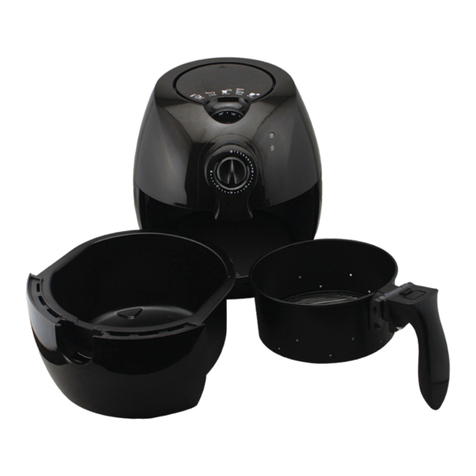
Kogan
Kogan KAFRYARBLK user manual
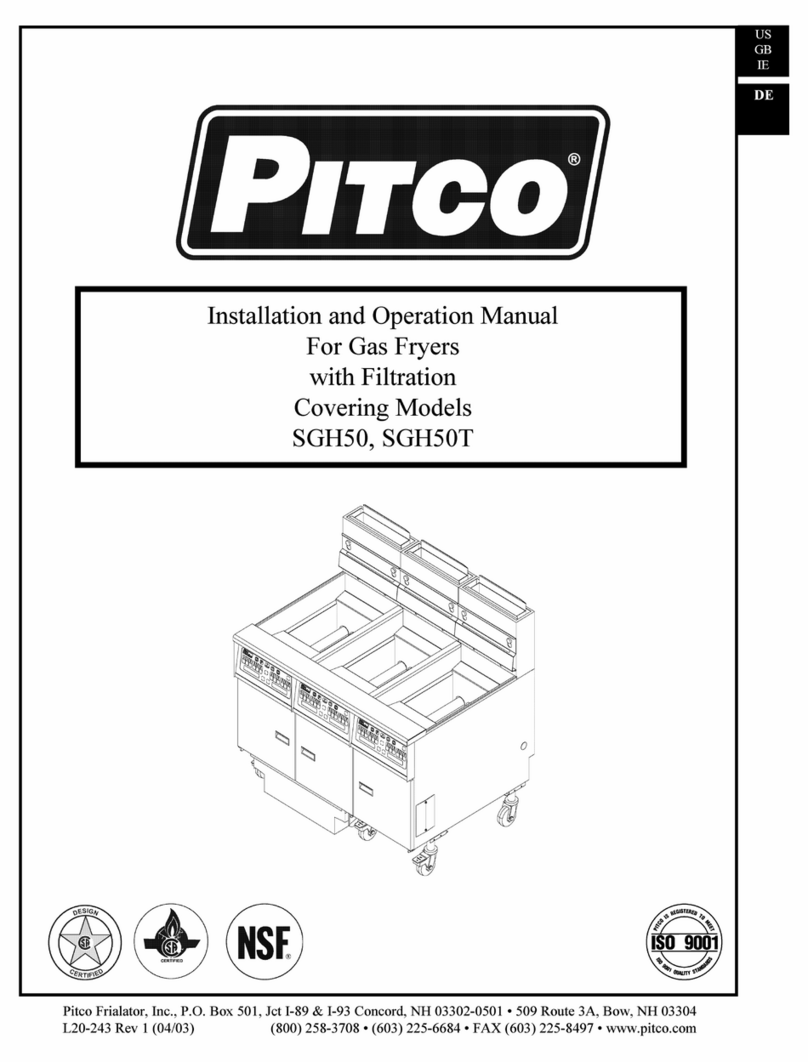
Pitco
Pitco SGH50 Installation and operation manual

Daewoo electricals
Daewoo electricals SDA1241 Instructions for use
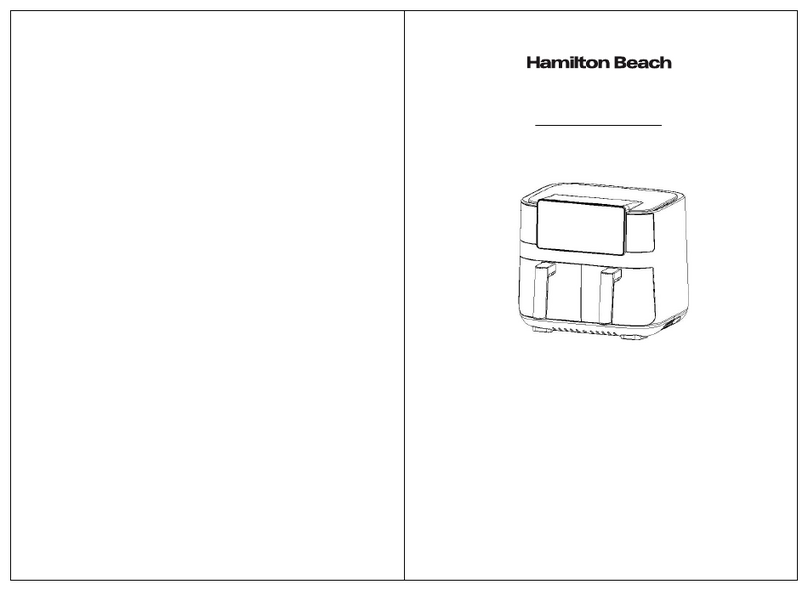
Hamilton Beach
Hamilton Beach HealthyCook HB4006 Operating and safety instructions

Beper
Beper BC.353 use instructions
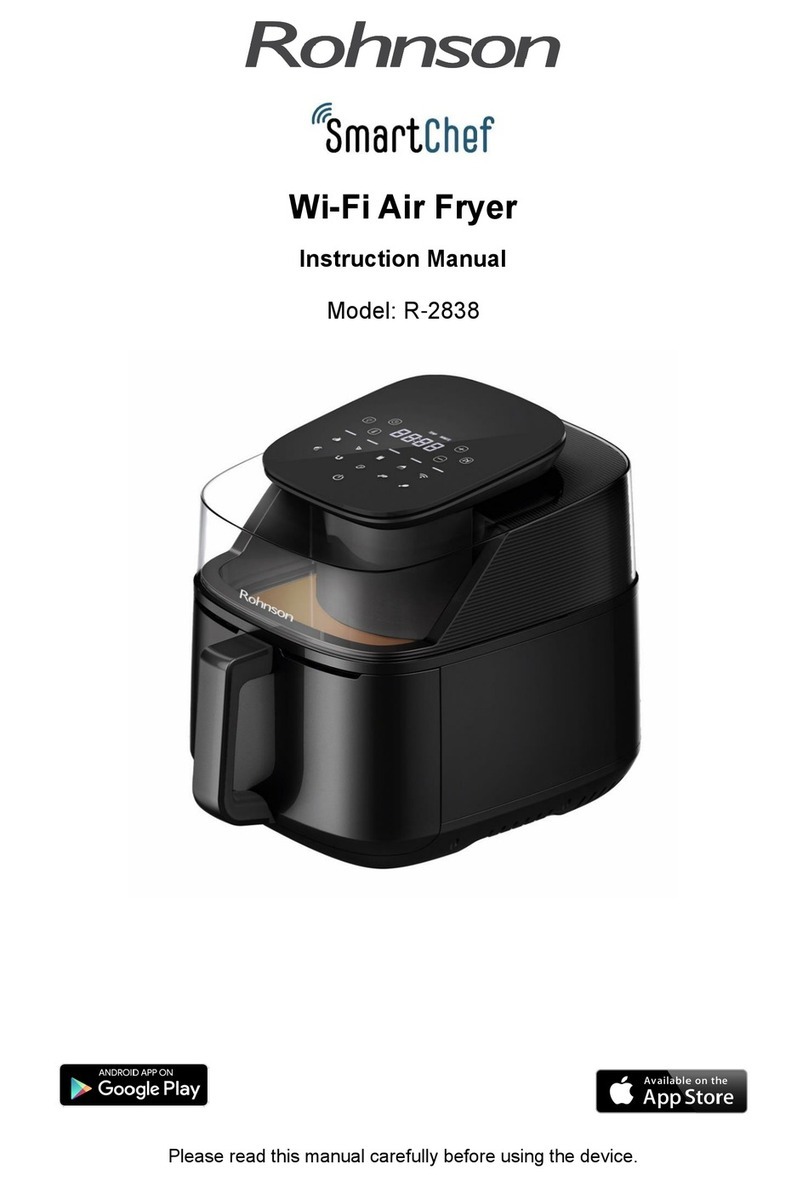
Rohnson
Rohnson Smartchef R-2838 instruction manual
